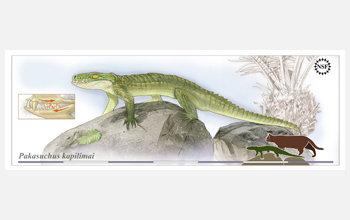Multimedia Gallery
Ancient Crocodile Pakasuchus kapilimai (Image 2)
Graphic comparing the size of the ancient crocodile Pakasuchus kapilimai to a housecat. P. kapilimai once roamed Tanzania in the Middle Cretaceous and had a number of features unusual for crocodylians, including mammal-like teeth and a flexible spine. Paleontologists scouring a river bank in Tanzania unearthed the previously unknown croc from 105 million-year-old, mid-Cretaceous rock in the Great East African Rift System. The discovery was made by an international team of researchers, led by Patrick O'Connor of Ohio University, who were funded in part by the National Science Foundation (NSF).
To learn more about this discovery, see the NSF press release These Crocs Were Made for Chewing?. Further information is also available in the NSF Special Report These Crocs Are Made for Biting!. (Date of Image: 2010) [See related image Here.]
Credit: Zina Deretsky, National Science Foundation
Images and other media in the National Science Foundation Multimedia Gallery are available for use in print and electronic material by NSF employees, members of the media, university staff, teachers and the general public. All media in the gallery are intended for personal, educational and nonprofit/non-commercial use only.
Images credited to the National Science Foundation, a federal agency, are in the public domain. The images were created by employees of the United States Government as part of their official duties or prepared by contractors as "works for hire" for NSF. You may freely use NSF-credited images and, at your discretion, credit NSF with a "Courtesy: National Science Foundation" notation.
Additional information about general usage can be found in Conditions.
Also Available:
Download the high-resolution JPG version of the image. (709 KB)
Use your mouse to right-click (Mac users may need to Ctrl-click) the link above and choose the option that will save the file or target to your computer.

